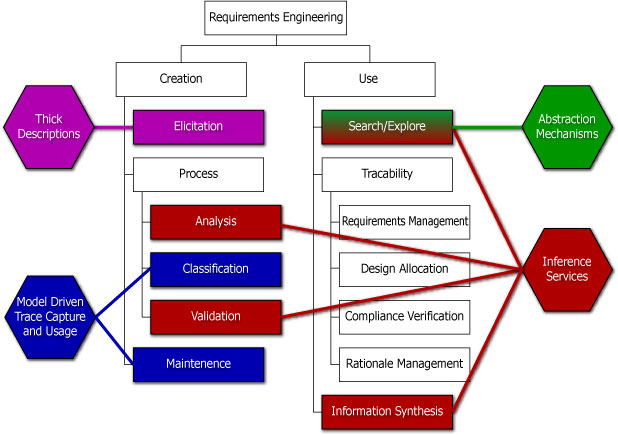|
Lessons Learned from Industry (e.g., DOORS and SLATE).
-
Support for Team Development
DOORS and SLATE both support a top-down approach to systems development.
Tool support for the bottom-up integration of subsystems is missing!
-
Visualization
DOORS and SLATE do not support domain-specific visualization of
engineering systems. Now that Javascript and XSLT are here,
this limitation can be mitigated.
-
Tools are Designed to be Process Neutral
DOORS and SLATE are designed to be process-independent tools -- that is,
a company supposedly use the tool to enhance any high-level
systems engineering process.
Company training procedures focus on step-by-step procedures for low-level tasks.
In practice, many employees have great difficulty in scheduling these
low-level tasks to match organizational processes.
Specific Limitations of Present-Day Tools (Selberg, 2002)

Figure 7. Requirements Engineering WBS and Industry Toolset Weakensses.
(For details, see Ramesh and Jarke, 2001)
-
Thick Descriptions.
Current tools lack the ability to store informal representations (i.e.,
so-called thick descriptions) of systems conveying information
along subtle or implied lines.
-
Model Driven Trace Capture and Usage.
Current tools lack mechansms for "easy linking" of
models into the design environment (e.g., SLATE).
-
Abstraction Mechanisms.
Current tools lack the ability to search and explore
requirements at various levels of abstraction.
-
Inference Services.
The lack of "inference services" in the work breakdown structure
impacts the systems engineering process in several ways.
Current tools are incapable of analyzing requirements for
completeness or consistency.
Search mechanisms are limited to keywords, which can be limiting
for custom jargon in multidisciplinary and multilingual projects.
|
![[Left]](images/button-left.gif)
![[Up]](images/button-up.gif)
![[Right]](images/button-right.gif)
![[Left]](images/button-left.gif)
![[Up]](images/button-up.gif)
![[Right]](images/button-right.gif)
![[Left]](images/button-left.gif)
![[Up]](images/button-up.gif)
![[Right]](images/button-right.gif)
![[Left]](images/button-left.gif)
![[Up]](images/button-up.gif)
![[Right]](images/button-right.gif)

![[Left]](images/button-left.gif)
![[Up]](images/button-up.gif)
![[Right]](images/button-right.gif)